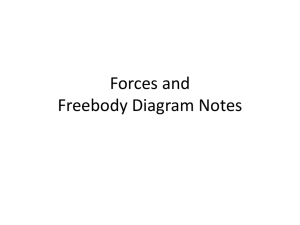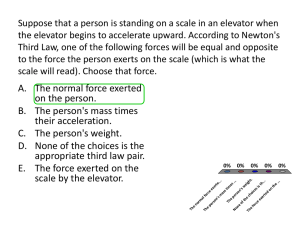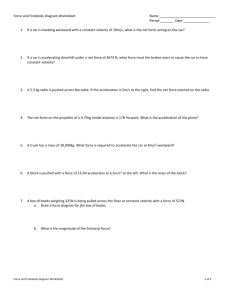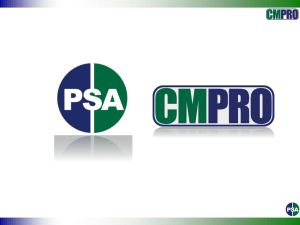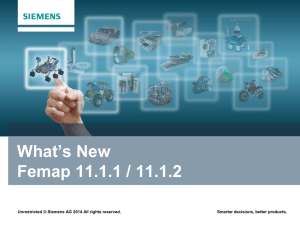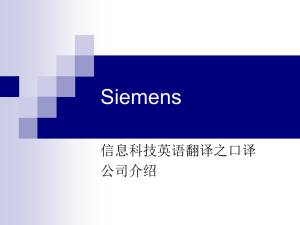Using the FEMAP Freebody Toolbox
advertisement
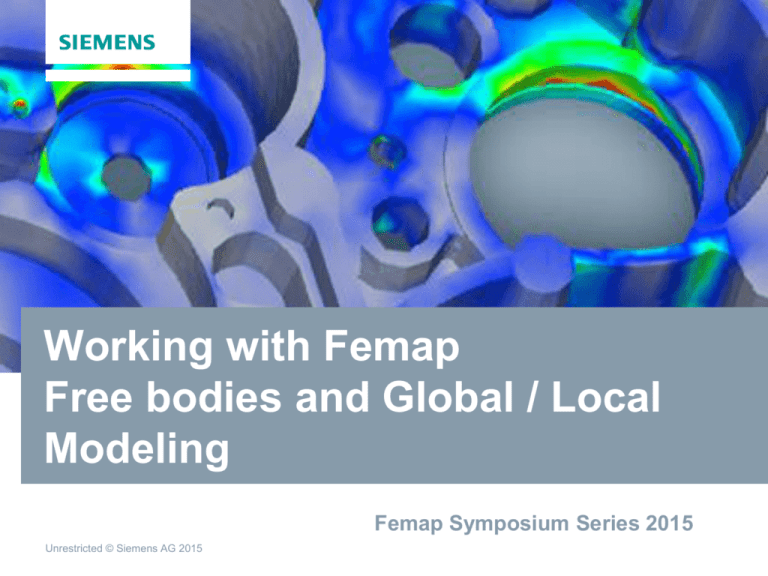
Working with Femap Free bodies and Global / Local Modeling Femap Symposium Series 2015 Unrestricted © Siemens AG 2015 Siemens PLM UK Symposium Femap Track Agenda 11:00: Femap – introduction and what’s new 11:50: Working with Femap – free bodies and global / local modeling 13:30: Femap industry customer case studies: Aerospace & marine Customer presentation Longitude Consulting Engineers (London Offshore Consulting) Your presenters today: Nick Rakkar Al Robertson Joe Brackin Peter Kingsland Page 2 UK Channel Sales Manager, Siemens PLM Software Product Marketing Manager, Siemens PLM Software Senior Software Engineer, Siemens PLM Software Naval Architect, Longitude Consulting Engineers Siemens PLM Software Siemens PLM UK Symposium Femap Track Agenda 15:40: • • • • Event wrap up We will be available for questions and discussion after the event Femap futures and roadmap Femap technical queries How can Femap help in your business Who can you talk to regarding software solution testing Nick Rakkar – UK Channel Sales Manager Nick.Rakkar@siemens.com 07837 553 633 Page 3 Siemens PLM Software FEMAP Freebody Deep Dive Topics • • • • • • • • What is a Freebody? Recovering Grid Point Forces in NASTRAN Understanding Grid Point Force Output Freebodies in FEMAP Using the FEMAP Freebody Toolbox FEMAP Freebody Options Global / Local Modelling with Freebodies Additional Topics Page 4 Siemens PLM Software What is a Freebody? Freebody Displays provide an insight into the internal forces and moments of the FEM • In FEMAP, Freebody display can be used to display a balanced set of loads on a portion of the structure or calculate the load across an interface • Freebody displays are commonly used when modeling practices dictate that the resulting FE mesh is a “coarse-grid” mesh but is suitable as an “internal loads” model • Commonly modeled structures are often too complicated to model in sufficient detail to obtain directly useable stresses • Allows for forces / moments to be extracted for detail stress analysis • Freebody displays are heavily used (but not limited to) in the aerospace industry Page 5 Siemens PLM Software Freebody Display Requires Recovering Grid Point Forces in NASTRAN Turning on the NASTRAN GPFORCE case control request is required to take full advantage of the FEMAP Freebody Tool • Enabling GPFORCE Output in NASTRAN Case Control • Analysis Manager • Master Requests and Conditions • Output Requests • Force Balance • GPFORCE requests can return a large amount of data, so this option is not enabled by default Page 6 Siemens PLM Software Freebody Display Requires Recovering Grid Point Forces in NASTRAN • FEMAP can work with a reduced set of data including applied load (OLOAD), constraint force (SPCFORCE), and constraint equation (MPCFORCE) • This is generally not recommended unless only a generic freebody display of the entire structure is all that’s required. • Care should be taken when not requesting GPFORCE data for the entire model. Page 7 Siemens PLM Software Understanding Grid Point Force Output NASTRAN F06 Output • When the results destination is set to “Print Only” or “Print and PostProcess” GPFORCE data can be viewed in the F06 file • Note that it is still recommended to read GPFORCE data into FEMAP from the OP2 file, not the F06 file • Search for “G R I D P O I N T F O R C E B A L A N C E” G R I D POINT-ID 0 0 Page 8 ELEMENT-ID 1 1 1 1 2 2 2 2 2 3 3 3 3 3 267 268 267 268 269 270 269 270 271 272 SOURCE F-OF-SPC QUAD4 QUAD4 *TOTALS* QUAD4 QUAD4 QUAD4 QUAD4 *TOTALS* QUAD4 QUAD4 QUAD4 QUAD4 *TOTALS* P O I N T T1 4.169596E-02 1.213303E-01 -1.630262E-01 9.436896E-16 -7.904667E-01 -3.752280E-01 5.058178E-01 6.598768E-01 -1.798561E-14 -2.833224E-01 -2.021358E-01 1.617432E-01 3.237150E-01 1.049161E-14 F O R C E T2 1.031393E+00 5.287078E+00 -6.318471E+00 -6.306067E-14 -1.515594E+02 -1.348000E+02 1.277458E+02 1.586136E+02 -1.136868E-12 -7.450614E+01 -4.297056E+01 5.205509E+01 6.542161E+01 8.540724E-12 B A L A N C E T3 -5.078434E+01 -1.944031E+01 7.022465E+01 2.557954E-13 3.756228E+02 -4.464662E+02 2.504629E+00 6.833877E+01 7.389644E-13 3.083269E+02 -3.489907E+02 -2.303685E+01 6.370063E+01 -2.700062E-13 R1 0.0 2.078351E-03 -2.078351E-03 1.934217E-16 1.975718E-01 1.780457E-01 -1.799477E-01 -1.956698E-01 6.383782E-16 1.501767E-01 1.569770E-01 -1.572558E-01 -1.498980E-01 1.665335E-16 R2 0.0 5.017486E-01 -5.017486E-01 0.0 5.075642E-01 -5.262242E-01 -1.129834E-01 1.316434E-01 1.493250E-14 -1.241496E-01 1.129076E-01 -2.788103E-01 2.900524E-01 -2.886580E-15 R3 0.0 4.834255E-04 -4.834255E-04 -2.333203E-16 1.493221E-02 2.671471E-02 -4.392642E-02 2.279495E-03 5.551115E-17 2.011796E-02 4.146868E-02 -1.574009E-02 -4.584655E-02 8.326673E-17 Siemens PLM Software Understanding Grid Point Force Output NASTRAN F06 Output • GPFORCE results are listed per grid and include Fxyz (T1, T2, T3) and Mxyz (R1, R2, R3) • Results are separated into 4 different categories, plus a summation • Elemental (discrete; per connecting flexible element) • Applied Load(total forces / moments applied on node; single quantity per node) • F-of-SPC (SPC forces on node; single quantity per node) • F-of-MPC (MPC forces on node, including both constraint equations and RBE contributions; single quantity per node) • *TOTALS* (total summation of all contributions; single quantity per node) • For the majority of cases, this value should be near zero, indicating equilibrium at the node Page 9 Siemens PLM Software Understanding Grid Point Force Output How GPFO Relates to Structure • Freebody display is dependent on the nodes and elements included in the summation • Deciding which nodes and elements are to be used is based on how the model was idealized as well as what specific quantity is desired Page 10 Siemens PLM Software Freebody Display in FEMAP Freebodies in FEMAP exist as creatable objects, like nodes, elements, etc. • They persist in the database • This is a huge benefit for recreating freebody displays in the future • Can help reduce analysis errors and rework • Any number of freebodies can be displayed simultaneously • Many tools exist to automate freebody-related tasks, such as creating loads and substructure modeling Page 11 Siemens PLM Software Freebody Display in FEMAP FEMAP Freebody Types – There are 3 types of freebody displays in FEMAP • Freebody – user selects the elements, FEMAP automatically selects related nodes. Intended to display a balanced set of loads on a discrete piece of structure Page 12 Siemens PLM Software Freebody Display in FEMAP FEMAP Freebody Types – There are 3 types of freebody displays in FEMAP • Interface Load – user selects both nodes and elements and FEMAP calculates a summation of loads and forces across the interface and displays as a single vector Page 13 Siemens PLM Software Freebody Display in FEMAP FEMAP Freebody Types – There are 3 types of freebody displays in FEMAP • Section Cut – similar to interface load, a summed load across an interface is calculated and displayed, however node and element selection is automated by FEMAP. The user selects a “cutting plane”. The cutting plane can then be dynamically located within the model using different methods. Page 14 Siemens PLM Software Freebody Display in FEMAP Freebody Load Contributions • Freebody load contributions in FEMAP are split into six categories • Applied – All applied loads • Reaction – SPC forces(Constraint forces) • MultiPoint Reaction – MPC(MultiPoint Constraint forces) • Peripheral Elements – include elements surrounding the selected elements • Freebody Elements – include elements selected by the user or by FEMAP • Nodal Summation – nodal summation values from the solver, not FEMAP calculated values • Default contributions are Applied, Reaction, MultiPoint Reaction and Peripheral elements • This provides forces and moments acting on the selected structure Page 15 Siemens PLM Software Freebody Display in FEMAP Freebody Result Vectors – As previously mentioned, the NASTRAN GPFORCE request is recommended to fully take advantage of the freebody tool, however the result quantities may be obtained from several different quantities Primary Secondary Applied GPFORCE OLOAD SPC GPFORCE SPCFORCE MPC GPFORCE MPCFORCE Elemental GPFORCE None Nodal Summation GPFORCE None The italicized rows above represent default output requests in FEMAP and are sufficient for displaying a balanced freebody on the entire structure, but not for display of internal load distribution. Page 16 Siemens PLM Software Using the FEMAP Freebody Toolbox Accessing the Freebody Toolbox • The Freebody Toolbox is located in the PostProcessing toolbox and can only be accessed when results are present in the model Global Settings – These controls affect all freebodies in the model. Control global display of freebodies, select output set (tied to contour and deform) and enable data summation on nodes Freebody Properties – These controls are related to individual freebodies, such as selecting nodes and elements View Properties – These are global settings that affect freebody visualization (symbol sizes, vector scaling, etc). Same as found in View Options (F6) Page 17 Siemens PLM Software Using the FEMAP Freebody Toolbox Creating a New Freebody • In the Freebody Toolbox, new Freebody Displays are created within the Freebody Manager • The New Freebody dialog allows for setup of basic settings, such as freebody type, vector display, and contribution selection • Any of the settings applied in the New Freebody dialog can be changed at any time within the toolbox Page 18 Siemens PLM Software Using the FEMAP Freebody Toolbox Accessing Different Freebody Displays • Multiple Freebody Displays can be viewed at any time however, only a single freebody can be active at any time within the toolbox • Use the drop-down menu to change the active freebody and then modify settings • Visibility of individual freebody displays can be controlled with the “Is Visible” checkbox as well as with the Visibility Quick View Dialog Page 19 Siemens PLM Software Using the FEMAP Freebody Toolbox Freebody Vector Types • Depending on the freebody type, there can be nodal vectors and a single total summation vector • Nodal Vectors • Displays the summation at each node, based on the selected freebody contributions • Available for all freebody types • Total Summation Vector • Displays the total summation across all nodes at a pre-defined position. The selected position does not affect summed force calculations, but will affect summed moment calculations (moment arms are different). • Available for Interface Load and Section Cut freebodies only. • Both force and moment vectors are available and can be individually toggled • Vectors can be displayed as either components or resultant vectors • Individual components can be toggled on and off Page 20 Siemens PLM Software Using the FEMAP Freebody Toolbox Freebody Vector Visualization Visibility Quick Toggle Buttons • All On / All Off • Forces On/Off • Moments On/Off • Toggle between resultant/component • Select summation location (interface load and section cut only) Page 21 Siemens PLM Software Using the FEMAP Freebody Toolbox Freebody Vector Visualization Detail Options • Additional detailed options for visualization can be found by expanding the Total Summation Vector and Nodal Vector(s) nodes • Select components displayed (Fx, Fy, Fz), (Mx, My, Mz) • Select components included in calculation (interface load and section cut only) Page 22 Siemens PLM Software Using the FEMAP Freebody Toolbox Freebody Coordinate Systems • The selected freebody coordinate system controls the coordinate system for both nodal vectors and the total summation vector (if applicable) for the selected freebody • Nodal vectors may optionally be displayed in the nodal output coordinate system • If no nodal output system was specified on the node, the default coordinate system used is the global rectangular system Page 23 Siemens PLM Software Using the FEMAP Freebody Toolbox Freebody Mode • When using “Freebody Mode”, the user selects elements and FEMAP will automatically select all related nodes • This mode is designed to display a balanced set of loads on a selected set of elements • Entities may be selected manually (default) or by a group select • The default contribution selections will display forces/moments acting on the selected elements Select Elements Reset Element Selection Highlight Selected Elements Page 24 Siemens PLM Software Using the FEMAP Freebody Toolbox Display of balanced set of loads on wingpost model. All elements in the model were selected for this display Page 25 Siemens PLM Software Using the FEMAP Freebody Toolbox Interface Load Mode • Interface load freebodies display nodal vectors for the selected nodes as well as a total summation vector at a selected location • Unlike freebody mode, interface load mode is not likely to be in equilibrium • In addition to element selection, nodes must be user selected– FEMAP does not infer them based on the selected elements • When selecting entities by group, both the nodes and elements of interest must exist in the group Page 26 Siemens PLM Software Using the FEMAP Freebody Toolbox Interface Load Mode – Selecting Nodes Locate Summation Vector at Node Centroid Select Free Edge Nodes Select Nodes Reset Node Selection Highlight Selected Nodes Only those elements connected to the selected nodes will be used in calculations Page 27 Siemens PLM Software Using the FEMAP Freebody Toolbox Interface Load Mode – Selecting Components in Summation • Individual force and moment contributions that are included in the total summation vector calculation toggled on and off • By default, all force and all moment vectors are included in the calculation • Changes made here will affect the total summation calculation • Turning on and off certain contributions is dependent on how the model was idealized ; it is up to the analyst to understand how the FE model correlates to real-world structure Page 28 Siemens PLM Software Using the FEMAP Freebody Toolbox Interface Load Display, Showing Summed Shear Load at a Rib Selected Nodes Highlighted Selected Elements Highlighted Page 29 Siemens PLM Software Using the FEMAP Freebody Toolbox Section Cut Mode • An extension to Interface Load Mode • The user defines a cutting plane in the model and the contributing freebody nodes and elements are determined automatically • Total summation location can be placed at • Plane/path intersection • Nodal centroid • Static location • Nodal and total summation vectors can optionally be aligned tangent to the path without having to create additional coordinate systems Page 30 Siemens PLM Software Using the FEMAP Freebody Toolbox Freebody Section Cut Entity Select Modes Plane: Cutting plane is defined via base point and normal vector. Path is defined as the normal vector; cutting plane will always be normal to the path Curve: Cutting plane is normal to the tangent vector at a point along the plane. Cutting plane will always be normal to the tangent vector Plane / Vector: Similar to Plane, however an additional vector is defined for the path. The cutting plane will always remain coplanar to the original plane and does not have to be normal to the path Vector: Cutting plane is normal to the defined vector. Path is the defined vector; cutting plane will always be normal to the path Page 31 Siemens PLM Software Using the FEMAP Freebody Toolbox Section cut defined using plane Page 32 Siemens PLM Software Using the FEMAP Freebody Toolbox Section cut defined using curve Page 33 Siemens PLM Software Using the FEMAP Freebody Toolbox Additional Section Cut options • Slider tool can be used to move the cutting plane along the length of the path interactively within the available entities • Section cut entities may be limited to a specific group or selected from the entire model, and can be limited to a search distance from the base location of the cutting plane • The cutting plane can optionally be given a thickness tolerance that will allow for accurate selection of entities that are slightly out-of-plane • Clipped entities can either be included or excluded from the summation calculations Page 34 Siemens PLM Software Using the FEMAP Freebody Toolbox Cut plane initial position Cut plane moved along the path Freebody nodes Freebody elements Page 35 Siemens PLM Software Freebody Display Output Options Freebody Tools 1 2 3 4 5 1 – List freebody to message window 2 – List freebody to data table 3 – List freebody summation to message window (interface load / section cut) 4 – List freebody summation to data table (interface load / section cut) 5 – Freebody validation tool; warns user when freebody results are potentially missing from the model Page 36 Siemens PLM Software Global-Local Modeling with Freebodies The Create Load from Freebody/Multi-Model tool automates the creation of global-local models • Used to map freebody loads from a coarse grid model to a fine grid model and automatically create connections with RBE3 elements • Start with a balanced freebody in a coarse model • FEMAP can automatically locate suitable target nodes in the fine grid FEM and will connect with RBE3 elements • Once properly constrained, the detail FEM is ready to run with a mapped set of loads • The detail FEM must exist in the same space as the part in the coarse grid FEM Page 37 Siemens PLM Software Global-Local Modeling with Freebodies • Select Source Model • Select Freebody • Select Output Sets • Multiple Sets allowed • Select Forces and/or Moments to be included Page 38 Siemens PLM Software Global-Local Modeling with Freebodies Define Target Model Parameters Freebody loads can be applied to target nodes based on: • Existing nodes (IDs must match) • Closest node in space to source node • Existing nodes to be connected with RBE3 elements • User can define target nodes or FEMAP can automatically find • Search distance can be limited • Maximum nodes to map can be limited Page 39 Siemens PLM Software Global-Local Modeling with Freebodies Source Model Freebody(Global Model) Target Model with RBE3 Load Distribution Page 40 Siemens PLM Software Additional Topics – Freebodies with NX Nastran Glue / Contact As of NX Nastran v10.1, the GPFORCE output request does not include contributions from glue or contact in the F06 or OP2 datablock • The result is a nodal imbalance that is the summation of all other contributions • Nodes that are affected by glue or contact will not be in equilibrium • The “TOTALS” quantity is equal and opposite to the existing summation G R I D 0 0 POINT-ID 686 686 686 686 686 686 686 686 686 10000 10000 ELEMENT-ID 821 822 827 828 857 858 863 864 468 SOURCE HEXA HEXA HEXA HEXA HEXA HEXA HEXA HEXA *TOTALS* HEXA *TOTALS* P O I N T1 -7.854530E-03 -4.059431E-03 7.568718E-03 -2.503399E-02 -2.316282E-02 -1.751655E-03 3.478360E-03 5.081535E-02 -1.318390E-16 2.385245E-17 2.385245E-17 T F O R C E T2 5.974986E-02 4.661321E-02 -6.126883E-02 -9.182400E-02 4.661320E-02 6.132058E-02 -9.182400E-02 3.061997E-02 5.620504E-16 5.842150E-02 5.842150E-02 B A L A N C E T3 7.854530E-03 2.316282E-02 -7.568719E-03 -3.478359E-03 4.059429E-03 1.751656E-03 2.503399E-02 -5.081535E-02 -4.440892E-16 3.122502E-17 3.122502E-17 R1 0.0 0.0 0.0 0.0 0.0 0.0 0.0 0.0 0.0 0.0 0.0 R2 0.0 0.0 0.0 0.0 0.0 0.0 0.0 0.0 0.0 0.0 0.0 R3 0.0 0.0 0.0 0.0 0.0 0.0 0.0 0.0 0.0 0.0 0.0 Glue/Contact Force balances the element force, but is not included in table Page 41 Siemens PLM Software Additional Topics – Freebodies with NX Nastran Glue / Contact In FEMAP 11.2, the ability to reverse the nodal summation value was added, allowing the nodal imbalance to be treated as a separate contribution in the equal-and-opposite direction • This option should only be used if the cause of the imbalance is known to be the result of data missing from the GPFO table(glue/contact force) and not caused by a modeling error. Page 42 Siemens PLM Software Additional Topics – Freebodies with NX Nastran Glue / Contact Page 43 Default contributions Freebody elements / nodal summation Freebody elements + nodal summation Reversed nodal summation Siemens PLM Software Additional Topics – Load from Freebody Tool Freebody results can be used to create loads within an existing model using the Model->Load->From Freebody tool • Works with all freebody modes • For interface load and section cut freebodies, total summation load can be created at a new node in the model • Loads can be created in an existing load set as well as in a new load set Page 44 Siemens PLM Software Additional Topics – Load from Freebody Tool Freebody Loads Page 45 Siemens PLM Software Additional Topics – Load from Freebody Tool Created Loads Page 46 Siemens PLM Software Additional Topics – Sum Data on Nodes Option By default, freebody vectors at each node are displayed as a summation of the selected components • A global setting allows for nodal quantities to be displayed as individual contributions. It affects all displayed freebodies • This allows for comparison of individual contributions to F06 data, as well as troubleshooting of models • This option is best used with the element shrink view option Page 47 Siemens PLM Software Additional Topics – Sum Data on Nodes Option Sum Data on node checked Sum Data on node unchecked, element shrink display ID: 342 Source Fx Fy Fz Mx My Mz ELEM 8 -4.12634 -2.76307 -130.752 46.32936 47.4351 -1.88713 ELEM 182 -18.5132 142.901 -466.199 0.280101 0.999626 0.022155 ELEM 80 208.315 34.15445 109.5391 0.067844 0.091289 -0.06195 Page 48 Siemens PLM Software Q and A Page 49 Siemens PLM Software Siemens PLM UK Symposium Femap Track Agenda 11:00: Femap – introduction and what’s new 11:50: Working with Femap – free bodies and global / local modeling 13:30: Femap industry customer case studies: Aerospace & marine Customer presentation Longitude Consulting Engineers (London Offshore Consulting) Your presenters today: Nick Rakkar Al Robertson Joe Brackin Peter Kingsland Page 50 UK Channel Sales Manager, Siemens PLM Software Product Marketing Manager, Siemens PLM Software Senior Software Engineer, Siemens PLM Software Naval Architect, Longitude Consulting Engineers Siemens PLM Software Siemens PLM UK Symposium Femap Track Agenda 15:40: • • • • Event wrap up We will be available for questions and discussion after the event Femap futures and roadmap Femap technical queries How can Femap help in your business Who can you talk to regarding software solution testing Nick Rakkar – UK Channel Sales Manager Nick.Rakkar@siemens.com 07837 553 633 Page 51 Siemens PLM Software
